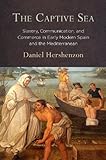The Captive Sea : Slavery, Communication, and Commerce in Early Modern Spain and the Mediterranean / Daniel Hershenzon.
Material type: TextPublisher: Philadelphia : University of Pennsylvania Press, [2018]Copyright date: ©2019Description: 1 online resource (304 p.) : 1 illusContent type:
TextPublisher: Philadelphia : University of Pennsylvania Press, [2018]Copyright date: ©2019Description: 1 online resource (304 p.) : 1 illusContent type: - 9780812295368
- Captivity -- Western Mediterranean -- History -- 17th century
- Captivity-Western Mediterranean-History-17th century
- Communication -- Western Mediterranean -- History -- 17th century
- Communication-Western Mediterranean-History-17th century
- Ransom -- Western Mediterranean -- History -- 17th century
- Ransom-Western Mediterranean-History-17th century
- Slave trade-Western Mediterranean-History-17th century
- Slavery -- Western Mediterranean -- History -- 17th century
- Slavery-Western Mediterranean-History-17th century
- Western Mediterranean-Commerce-History-17th century
- Western Mediterranean-History-17th century
- HISTORY / Renaissance
- European History
- History
- Medieval and Renaissance Studies
- World History
- DE96 .H47 2018
- online - DeGruyter
| Item type | Current library | Call number | URL | Status | Notes | Barcode | |
|---|---|---|---|---|---|---|---|
 eBook
eBook
|
Biblioteca "Angelicum" Pont. Univ. S.Tommaso d'Aquino Nuvola online | online - DeGruyter (Browse shelf(Opens below)) | Online access | Not for loan (Accesso limitato) | Accesso per gli utenti autorizzati / Access for authorized users | (dgr)9780812295368 |
Frontmatter -- Contents -- A Note on the Text -- Introduction -- 1. The Social Life of Enslaved Captives -- 2. Ransom: Between Economic, Political, and Salvific Interests -- 3. Negotiating Ransom, Seeking Redemption -- 4. Taking Captives, Capturing Communities -- 5. Confronting Threats, Countering Violence -- 6. Moving Captives, Moving Knowledge -- 7. The Political Economy of Ransom -- Conclusion -- Notes -- Bibliography -- Index -- Acknowledgments
restricted access online access with authorization star
http://purl.org/coar/access_right/c_16ec
In The Captive Sea, Daniel Hershenzon explores the entangled histories of Muslim and Christian captives—and, by extension, of the Spanish Empire, Ottoman Algiers, and Morocco—in the seventeenth century to argue that piracy, captivity, and redemption formed the Mediterranean as an integrated region at the social, political, and economic levels. Despite their confessional differences, the lives of captives and captors alike were connected in a political economy of ransom and communication networks shaped by Spanish, Ottoman, and Moroccan rulers; ecclesiastic institutions; Jewish, Muslim, and Christian intermediaries; and the captives themselves, as well as their kin.Hershenzon offers both a comprehensive analysis of competing projects for maritime dominance and a granular investigation of how individual lives were tragically upended by these agendas. He takes a close look at the tightly connected and ultimately failed attempts to ransom an Algerian Muslim girl sold into slavery in Livorno in 1608; the son of a Spanish marquis enslaved by pirates in Algiers and brought to Istanbul, where he converted to Islam; three Spanish Trinitarian friars detained in Algiers on the brink of their departure for Spain in the company of Christians they had redeemed; and a high-ranking Ottoman official from Alexandria, captured in 1613 by the Sicilian squadron of Spain.Examining the circulation of bodies, currency, and information in the contested Mediterranean, Hershenzon concludes that the practice of ransoming captives, a procedure meant to separate Christians from Muslims, had the unintended consequence of tightly binding Iberia to the Maghrib.
Mode of access: Internet via World Wide Web.
In English.
Description based on online resource; title from PDF title page (publisher's Web site, viewed 26. Mai 2021)


